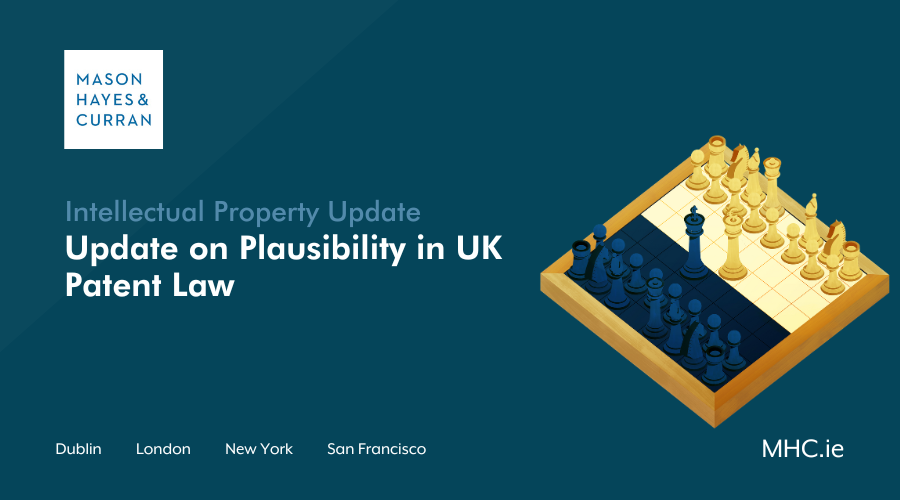
The UK Court of Appeal ruled in favour of Teva and Sandoz in their joint revocation proceedings concerning Bristol-Myers Squibb’s Supplementary Protection Certificate for a product called Apixaban. Gerard Kelly, Head of Intellectual Property, reviews the courts finding which clarifies the concept of plausibility.
The UK Court of Appeal[1] dismissed Bristol-Myers Squibb’s (BMS) appeal, upholding a decision of the High Court of England and Wales. That decision had previously found BMS’s patent for Apixaban is invalid. Teva and Sandoz claimed that BMS’s Supplementary Protection Certificate (SPC) for a drug called Apixaban should be revoked. We review the Court of Appeal’s decision which provides clarity on the UK position regarding plausibility in terms of insufficiency.
Background - claim that the Patent is not plausible
The SPC in question extends the exclusive rights BMS enjoys under European Patent (UK) 1 427 415 entitled “Lactam-containing compounds and derivatives thereof as factor Xa inhibitors” (the Patent). The Patent expired on 17 September 2022 and the SPC is due to expire on 19 May 2026. Apixaban is a drug produced by BMS under the brand name Eliquis.
Teva and Sandoz both agree that Apixaban is a proven potent factor Xa inhibitor. However, the parties argued that the Patent was invalid because the specification did not make it plausible, or credible, that Apixaban would have any useful Xa inhibitory activity. This is the first case in which the UK Court of Appeal has determined a patent with a single claim to a pharmaceutical compound to be invalid based on the concept of plausibility.
Plausibility
Plausibility is not actually a term that is mentioned in the UK Patent Act, nor the Irish equivalent. The criterion of plausibility is a concept born from national and EPO case law. Plausibility may be considered under the statutory requirements:
- For a patent to involve an inventive step (Article 52 of the European Patent Convention (EPC)) and / or
- The requirement that an application for a patent be sufficiently clear and complete for it to be carried out by a person skilled in the art (Article 83 of the EPC).
Article 56 of the EPC links to these requirements. It states that an invention will be considered as involving an inventive step if, having regard to the state of the art, it is not obvious to a person skilled in the art.
In this case, it was submitted that the claimed invention made no technical contribution/effect to the art and therefore lacked an inventive step and was insufficiently disclosed. A key consideration when assessing whether an invention involves an inventive step is whether:
- The technical effect claimed by the patentee is derivable from the patent application by the skilled person when read with the common general knowledge (CGK) of that skilled person.
High Court judgment
In the trial judge’s view plausibility should be based on the principle in Warner-Lambert[2] that a contribution by the patentee that is in the specification is needed. BMS’s case for plausibility was grounded on matters in the CGK, not anything in the patent application. Ultimately the judge concluded that the patent application did not contain a reference to Apixaban which would infer that it is one of the compounds for which a useful result had been achieved. If there is no plausibility of any meaningful factor Xa binding it follows that the Patent is invalid since all the applications for Apixaban depend on factor Xa binding.[3]
Court of Appeal’s decision
BMS’s grounds of appeal included the point that the Patent in question and the application in Warner-Lambert differed factually (single compound versus second medical claim), therefore its patent application was legally distinguishable.
Lord Justice Arnold rejected BMS’s submission. Critically, he confirmed that the standard of plausibility to be applied is the standard set in Warner-Lambert[4]. It is not sufficient for the application to encourage the skilled reader to carry out tests in the specification to confirm efficacy, even where carrying out such tests would show the product is likely to be efficacious. Lord Justice Arnold noted that the Warner-Lambert concept has been applied in a number of decisions concerning single compound assessments. He further noted that the fundamental principle remains, regardless of whether the scope is broad or narrow, that is that the scope of the patent monopoly must be justified by the patentee’s contribution to the art.
The UK Supreme Court declined to hear an onward appeal, so this judgment represents the final limb of these proceedings.
Relationship with EPO Decision G2/21
This case was determined in the wake of the EPO decision G2/21 which had cast doubt over plausibility as a legal concept. In that case, the Enlarged Board of Appeal held that there is no requirement for a technical effect to be directly supported by data in the original patent application and the patentee successfully relied on post-published evidence to prove a technical effect.
It was therefore hoped that the UK Court of Appeal decision in Sandoz v BMS would clarify the position with regard to plausibility in the UK – an approach which now seemed to differ from its European counterpart. Lord Justice Arnold ruled that the court was bound by the Supreme Court decision in Warner-Lambert v Actavis and the EPO decision did not warrant a departure away from the established UK case law.
On the issue of post- published evidence as either demonstrating or supporting a technical effect in a patent application, Lord Justice Arnold again confirmed the Supreme Court’s position that post-published data could not be used as a substitute for sufficient disclosure in the specification.
Clarity- positive news for generics
In parallel proceedings[4] in Ireland, Mr Justice Barrett agreed with the rationale of the Court of Appeal regarding its application of the plausibility test.
This decision confirms that the scope of what can be claimed in patents is narrowed where specifications do not sufficiently disclose claimed inventions. With this clarification, generics should feel more confident in challenging applications based on insufficiency in the UK and Ireland. Conversely, patent applicants should take care to ensure there is sufficient data in their application to suppose any technical effects.
For more information and expert legal advice on how best to protect your company’s intellectual property rights, please contact a member of our award-winning Intellectual Property team.
[1] Sandoz and Teva v BMS [2023] EWCA Civ 472
[2] Warner-Lambert Co LLC v Generics (UK) Ltd [2018] UKSC 56
[3] Sandoz and Teva v BMS [2022] EWHC 822 (Pat) at para 217
[4] BMS v Norton (Teva) 2021/4758 P
The content of this article is provided for information purposes only and does not constitute legal or other advice.





